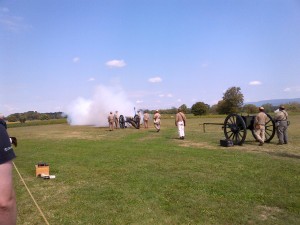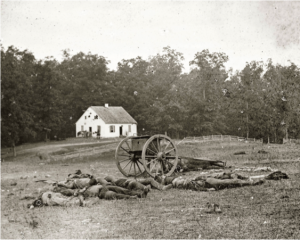The Great American Battle for Principle – and it’s not Afghanistan
SHARPSBURG (Maryland): We head for Antietam, site of the bloodiest one-day battle in American history, on the very day the news media are reporting the death of the 2,000thAmerican service member in Afghanistan since 2001.
Never mind that this statistic seems a trifle stale ( The New York Times reported the 2,000th casualty on August 21 and now, here it is again). But it also seems a tad pallid in relation to Antietam’s bloody toll.
Here, 150 years ago, on this peaceful stretch of cornfield, church and woods, more than 20,000 men fell to their deaths in the course of a single day. September 17, 1862 was the turning point in the four-year American Civil War, which ended with the abolition of slavery. As the US National Parks Service, which manages Antietam, says, “23,000 soldiers, wounded or missing after twelve hours of savage combat on September 17, 1862. The Battle of Antietam ended the Confederate Army of Northern Virginia’s first invasion into the North and let to Abraham Lincoln’s issuance of the preliminary Emancipation Proclamation.”
Twenty-three thousand dead at Antietam in a single day. Two-thousand in Afghanistan over 11 years. Every death is tragic and one too many but could Antietam’s lesson be the de-romanticising of war? Antietam’s toll was photographed and the bloody reality of war relayed to the public. It was the first time an American battlefield had ever been photographed before the dead had been buried. People learnt that war was grim, bloody, painful; it was hell and only worth pursuing if all other options had failed. In fact, the Battle of Antietam illustrates this extraordinarily well and in a way that finds resonance in our intensely wired age.
Alexander Gardner’s 70 photographs of the battlefield, starting September 19, just two days after the war, have gone on to become stark, standard inclusions in American schoolbooks. The photograph above shows those who fell in front of Dunker Church at Antietam.

A 21st-century re-enactment of the action. Photo by Rashmee Roshan Lall
It feels ghoulish to walk the same path today. There is no longer any trace of the blood that soaked through this soil, but I can see the photographs in my mind’s eye.
***
Want a bit more? Listen to the BBC World Service‘s take on re-enactment of a 150-year-old war

“Our battered suitcases were piled on the sidewalk again; we had longer ways to go. But no matter, the road is life”
– Jack Kerouac


